《病原生物学(医学微生物学)》课程教学课件(英文)04_Microbial Metabolism
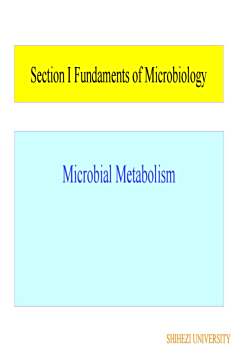
Section IFundaments of MicrobiologyMicrobial MetabolismSHIHEZI UNIVERSITY
Section I Fundaments of Microbiology Microbial Metabolism SHIHEZI UNIVERSITY
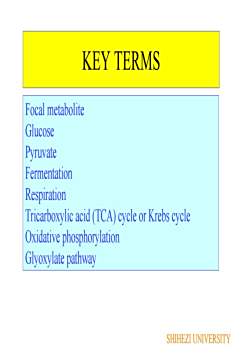
KEY TERMSFocal metaboliteGlucosePyruvateFermentationRespirationTricarboxylic acid (TCA) cycle or Krebs cycleOxidative phosphorylationGlyoxylate pathwaySHIHEZI UNIVERSITY
KEY TERMS Focal metabolite Glucose Pyruvate Fermentation Respiration Tricarboxylic acid (TCA) cycle or Krebs cycle Oxidative phosphorylation Glyoxylate pathway SHIHEZI UNIVERSITY
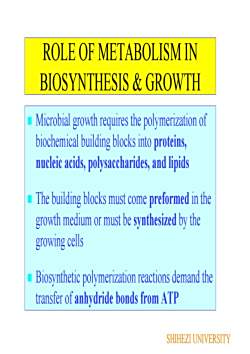
ROLE OF METABOLISMINBIOSYNTHESIS & GROWTHMicrobial growth requires the polymerization ofbiochemical building blocks into proteinsnucleic acids, polysaccharides, and lipids The building blocks must come preformed in thegrowth medium or must be synthesized by thegrowing cellsBiosynthetic polymerization reactions demand thetransfer of anhydride bonds from ATPSHIHEZI UNIVERSITY
ROLE OF METABOLISM IN BIOSYNTHESIS & GROWTH Microbial growth requires the polymerization of biochemical building blocks into proteins, nucleic acids, polysaccharides, and lipids The building blocks must come preformed in the growth medium or must be synthesized by the growing cells Biosynthetic polymerization reactions demand the transfer of anhydride bonds from ATP SHIHEZI UNIVERSITY
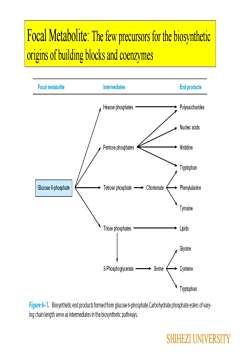
Focal Metabolite: The few precursors for the biosyntheticorigins of building blocks and coenzymesFocal metaboliteIntermediatesEnd productsPolysaccharidesHexose phosphatesNucleic acidsHistidinePentosephosphatesTryptophanGlucose 6-phosphate→PhenyalanineTetrosephosphate→ChorismateTyrosine+ LipidsTriose phosphatesGlycine3-Phosphoglycerate→Serine→ CysteineTryptophanFigure61Biosyntheticendproductsfomedfomglucos6-phosphateCarbohydratephophateestersofvaryingchainlengthserveasintermediatesinthebiosyntheticpathwaysSHIHEZIUNIVERSITY
Focal Metabolite: The few precursors for the biosynthetic origins of building blocks and coenzymes SHIHEZI UNIVERSITY
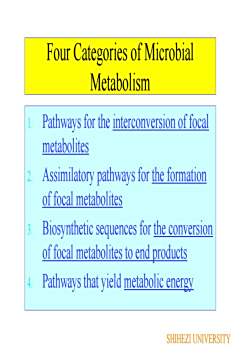
Four Categories of MicrobialMetabolismPathways for the interconversion of focametabolitesAssimilatory pathways for the formationof focal metabolitesBiosynthetic sequences for the conversionof focal metabolites to end productsPathways that yield metabolic energySHIHEZI UNIVERSITY
Four Categories of Microbial Metabolism 1. Pathways for the interconversion of focal metabolites 2. Assimilatory pathways for the formation of focal metabolites 3. Biosynthetic sequences for the conversion of focal metabolites to end products 4. Pathways that yield metabolic energy SHIHEZI UNIVERSITY
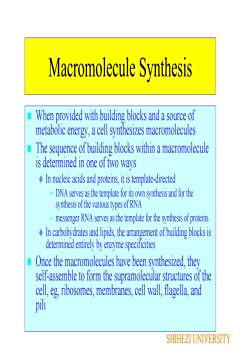
Macromolecule SynthesisWhen provided with building blocks and a source ofmetabolic energy, a cell synthesizes macromolecules The sequence of building blocks within a macromoleculeis determined in one of two ways In nucleic acids and proteins, it is template-directedDNA serves as the template forits own synthesis and for thesynthesis of the various types of RNAmessenger RNA serves as thetemplateforthesynthesis of proteinsIn carbohydrates and lipids, the arrangement of building blocks isdetermined entirely by enzyme specificitiesOnce the macromolecules have been synthesized, theyself-assemble to form the supramolecular structures of thecell, eg, ribosomes, membranes, cell wall, flagella andpiliSHIHEZIUNIVERSITY
Macromolecule Synthesis When provided with building blocks and a source of metabolic energy, a cell synthesizes macromolecules The sequence of building blocks within a macromolecule is determined in one of two ways In nucleic acids and proteins, it is template-directed DNA serves as the template for its own synthesis and for the synthesis of the various types of RNA messenger RNA serves as the template for the synthesis of proteins. In carbohydrates and lipids, the arrangement of building blocks is determined entirely by enzyme specificities Once the macromolecules have been synthesized, they self-assemble to form the supramolecular structures of the cell, eg, ribosomes, membranes, cell wall, flagella, and pili SHIHEZI UNIVERSITY
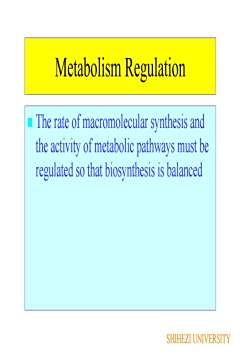
Metabolism RegulationThe rate of macromolecular synthesis andthe activity of metabolic pathways must beregulated so that biosynthesis is balancedSHIHEZI UNIVERSITY
Metabolism Regulation The rate of macromolecular synthesis and the activity of metabolic pathways must be regulated so that biosynthesis is balanced SHIHEZI UNIVERSITY
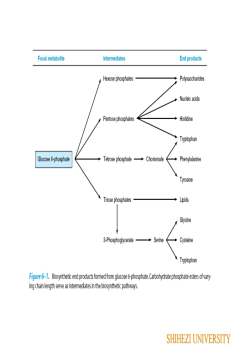
Focal metaboliteEnd productsIntermediatesPolysaccharidesHexose phosphatesNucleic acids二+HistidinePentose phosphatesTryptophanGlucose6-phosphate+PhenylalanineTetrosephosphate→ChorismateTyrosineTriose phosphatesLipidsGlycine3-Phosphoglycerate+Serine+CysteineTryptophanFigure6Biosyntheticendproductsfomedfomglucos6phophateCarbohydratephophateestersofvarying chain length serve as intermediates in the biosynthetic pathways.SHIHEZI UNIVERSITY
SHIHEZI UNIVERSITY
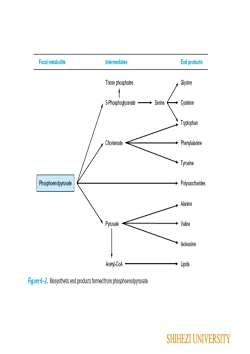
Focal metabolteIntermediatesEnd productsTriose phosphatesGlycine+SerineCysteine3-PhosphoglycerateTryptophanChorismate+ PhenylalanineTyrosinePhosphoenolpyruvatePolysaccharidesAlanine★ValinePyruvateIsoleucineAcetyl-CoA+LipidsFigure62BiosyntheticendproductfomedfomphosphoenolpyruateSHIHEZIUNIVERSITY
SHIHEZI UNIVERSITY
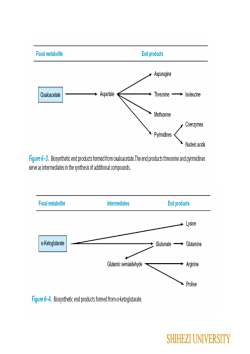
Focal metaboliteEnd productsAsparagineAspartateThreonine→IsoleucineOxaloacetateMethionineCoenzymesPyimidinesNucleic acidsFigure3BioytheticndproductomedfromxaloacetatThendproductsthreonineandpyrimidinesserveas intermediatesin thesynthesis of additional compoundsIntermediatesFocal metaboliteEnd productsLysinea-KetoglutarateGlutamineGlutamate→Glutamic semialdehydeArginineProlineFigure6-4. Biosynthetic end productsformed from a-ketoglutarateSHIHEZI UNIVERSITY
SHIHEZI UNIVERSITY
按次数下载不扣除下载券;
注册用户24小时内重复下载只扣除一次;
顺序:VIP每日次数-->可用次数-->下载券;
- 《病原生物学(医学微生物学)》课程教学课件(英文)06_Bacteria Pathogenesis.pdf
- 《病原生物学(医学微生物学)》课程教学课件(英文)07_Normal microbial flora.pdf
- 《病原生物学(医学微生物学)》课程教学课件(英文)13_Enterobacteriaceae.pdf
- 《病原生物学(医学微生物学)》课程教学课件(英文)12_Nesseria.pdf
- 《病原生物学(医学微生物学)》课程教学课件(英文)10_Staphylococcus.pdf
- 《病原生物学(医学微生物学)》课程教学课件(英文)18_Virio_Vampylo_Helico.pdf
- 《病原生物学(医学微生物学)》课程教学课件(英文)17_Pseudomonoads_acinetobacter.pdf
- 《病原生物学(医学微生物学)》课程教学课件(英文)19A_Haemophilus_Bordetella.pdf
- 《病原生物学(医学微生物学)》课程教学课件(英文)22_Lab Diagnosis for Bacterial Infections.pdf
- 《病原生物学(医学微生物学)》课程教学课件(英文)21_Non-spore-forming G+ bacilli_Corynebacterium_Listeria_Actinomycetes.pdf
- 《病原生物学(医学微生物学)》课程教学课件(英文)20_Yersinia_Pasteurella.pdf
- 《病原生物学(医学微生物学)》课程教学课件(英文)19B_Brucella_Francisella.pdf
- 《病原生物学(医学微生物学)》课程教学课件(讲稿)01 绪论.pdf
- 《病原生物学(医学微生物学)》课程教学课件(讲稿)02 细菌形态结构.pdf
- 《病原生物学(医学微生物学)》课程教学课件(讲稿)09-1 微生物感染的病原学检查法.pdf
- 《病原生物学(医学微生物学)》课程教学课件(讲稿)03 细菌生理.pdf
- 《病原生物学(医学微生物学)》课程教学课件(讲稿)06 真菌的基本性状.pdf
- 《病原生物学(医学微生物学)》课程教学课件(讲稿)05 病毒基本性状.pdf
- 《病原生物学(医学微生物学)》课程教学课件(讲稿)07 微生物感染与致病机制.pdf
- 《病原生物学(医学微生物学)》课程教学课件(讲稿)08 抗感染免疫.pdf
- 《病原生物学(医学微生物学)》课程教学课件(英文)05_Bacteria Genetics.pdf
- 《病原生物学(医学微生物学)》课程教学课件(英文)08_Spore-forming G+ bacilli_Clostridia.pdf
- 《病原生物学(医学微生物学)》课程教学课件(英文)02_Bacteria Growth_Survival_Death_01.pdf
- 《病原生物学(医学微生物学)》课程教学课件(英文)03_Cultivation of Microorganisms.pdf
- 《病原生物学(医学微生物学)》课程教学课件(英文)03_BacterialPhysiology.pdf
- 《病原生物学(医学微生物学)》课程教学课件(英文)00_Introduction.pdf
- 《病原生物学(医学微生物学)》课程教学课件(英文)01_BacterialStructure.pdf
- 《病原生物学(医学微生物学)》课程教学课件(2012)第36章 真菌学总论.pdf
- 《病原生物学(医学微生物学)》课程教学课件(2012)第35章 阮粒(Prion).pdf
- 《病原生物学(医学微生物学)》课程教学课件(2012)第37章 主要病原性真菌.pdf
- 《病原生物学(医学微生物学)》课程教学课件(2012)第34章 其他病毒.pdf
- 《病原生物学(医学微生物学)》课程教学课件(2012)第33章 反转录病毒.pdf
- 《病原生物学(医学微生物学)》课程教学课件(2012)第28章 急性胃肠炎病毒(Acute gastroenteritis virus).pdf
- 《病原生物学(医学微生物学)》课程教学课件(2012)第27章 肠道病毒 enterovirus.pdf
- 《病原生物学(医学微生物学)》课程教学课件(2012)第30章 虫媒病毒.pdf
- 《病原生物学(医学微生物学)》课程教学课件(2012)第32章 疱疹病毒.pdf
- 《病原生物学(医学微生物学)》课程教学课件(2012)第29章 肝炎病毒.pdf
- 《病原生物学(医学微生物学)》课程教学课件(2012)第26章 呼吸道病毒 Viruses associated with respiratory infections.pdf
- 《病原生物学(医学微生物学)》课程教学课件(2012)第24章 病毒的感染与免疫.pdf
- 《病原生物学(医学微生物学)》课程教学课件(2012)第23章 病毒学.pdf
